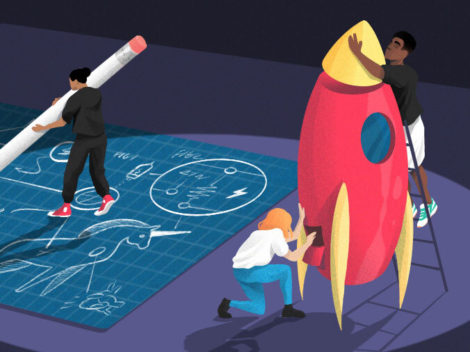Silicon Valley is best known for its ability to dream up and build tomorrow’s hardware and software products. It’s less known as a fashion hub.
Tech pioneers like Bill Gates and Mark Zuckerberg, for example, are hardly fashion icons. The fashion-backward status of tech’s home base is even the fodder of jokes. Venture capitalists in industry-standard Patagonia vests, and short-lived shoe trends, like the current Allbirds craze, are well-worn punchlines. Spectacles were even cool for a hot second. In short, what Silicon Valley lacks in style sense it makes up for in rigid and oft-sartorial norms.
Follow Crunchbase News on Twitter & Facebook
However, that doesn’t mean entrepreneurs and investors have completely ignored the clothing, apparel, and personal grooming verticals. In fact, in the current boom, where the moniker of “tech” has been applied to just about anything, and everything, there’s more activity in the apparel and grooming space than you might have expected.
VCs Have A Lot Of Clothes
The US apparel industry has impressive market potential. According to Statista, “the U.S. market for apparel and footwear reached around 331.49 billion U.S. dollars.” For founders and the VCs who fund them, that’s a lot of market to chip away at and, possibly, own with the right bets.
To find out just how fashionable the market is to founders and VCs, Crunchbase News analyzed 1,314 total funding deals made into US-headquartered startups since 2010. The list of companies include startups that sell, manufacture, or distribute apparel and personal grooming items. (You can find the Crunchbase query used for our analysis here.)
Overall, the apparel and grooming market has pulled in a respectable amount of venture capital, totaling over $5.4 billion in known fundings. Of that $5.4 billion, over $287 million has gone into seed-stage deals in the sector.
Here’s how that money has been dispersed in deal size and round count over time:

As can be plainly seen, from 2010 to 2014, interest in funding a swath of apparel and grooming startups was popular with VCs. The period produced large rounds in many popular startups, including Gilt Groupe, Harry’s, Warby Parker, Bonobos, Nasty Gal, Teespring, and Stitch Fix.
However, even though a number of well-known startups were birthed from 2010 to 2014, actual funding amounts stayed relatively steady from 2011 to 2013. And while the number of deals capped out in 2014, the amount of money invested into this sector of startups hit a hard peak in 2015. But since the days of Warby Parker’s $100 million Series D made in April 2015—a round that firmly put the eyewear fashion company on the Crunchbase Unicorn leaderboard—the apparel and grooming industry has experienced a degradation similar to Allbirds inability to make shoes that last.
Based on known fundings and deals, both 2016 and 2017 (YTD) totals have been sorely disappointing compared to previous years. Funding and deal counts have fallen well under highs starting in 2016, and it is likely that, unless a big deal is struck, 2017 and 2016 combined will fall under 2015’s funding peak and 2014’s deal count peak. For founders looking for funding, this isn’t an encouraging funding environment. So why are VCs drying the well? One possible factor is the varied results of funding an apparel or grooming company. Out of the top funded companies in the space, here is where just a few of them stand:
- Gilt Groupe. An online shopping website for designer labels via flash sales, the Gilt Groupe raised a total of $271 million, putting its valuation at $1 billion. But the company couldn’t match its sale to a valuation, and later sold to the Hudson Bay Company for a disappointing $250 million.
- Bonobos. The upscale men’s fashion store raised over $127 million in funding from Accel Partners, Nordstrom, and others. The startup was acquired by Walmart this year for $310 million in cash. According to ReCode, that acquisition price is just slightly more than its 2014 valuation of $300 million.
- Nasty Gal. Once a bit of a cultural phenomenon due to its impressive sales and founder Sophia Amoruso’s NYT best seller #GIRLBOSS, the apparel startup was unable to reconcile its ballooning marketing costs with customer retention. Due to this, the company claimed bankruptcy in February 2017. According to Crunchbase, investors put $65 million into the startup. Following the bankruptcy, Boohoo acquired Nasty Gal for $20 million. Boohoo, indeed.
- Teespring. A commerce platform for shirt sellers, Teespring also experienced a ton of growth in a compact amount of time. But as Crunchbase News discovered, Teespring, due to dependencies on Facebook for sales and other factors, was forced to layoff a significant amount of its staff. The company then later experienced a harsh recapitalization.
Of course, this is VC. Failures are expected. But excluding Gilt, which was acquired in 2016, 2017 hasn’t been a great year for apparel based startups and their investors. And it’s possible that, until a breakout success in the sector occurs, VCs will continue to withhold funds.
Thankfully, a comeback is still possible. Warby Parker and Harry’s, a startup that sells razors and is on the emerging unicorn board, appear to be doing well. Furthermore, Stitch Fix, a platform that curates apparel and accessories, is on Crunchbase News’ list of IPOs to watch. If just one of these startups can manage a public debut or a high-priced acquisition, apparel startups may regain their luster.
In the meantime, however, VCs have decided tech’s sense of fashion isn’t worth the money.
Illustration: Li-Anne Dias

Stay up to date with recent funding rounds, acquisitions, and more with the Crunchbase Daily.



![Illustration of a guy watering plants with a blocked hose - LatAm [Dom Guzman]](https://news.crunchbase.com/wp-content/uploads/quarterly-lat-america-470x352.jpg)

![Illustration of a magnet attracting various products. [Dom Guzman]](https://news.crunchbase.com/wp-content/uploads/mergers_and_acquisitions-470x352.jpg)
![Illustration of a guy watering plants with a blocked hose - Global [Dom Guzman]](https://news.crunchbase.com/wp-content/uploads/quarterly-global-3-300x168.jpg)
67.1K Followers